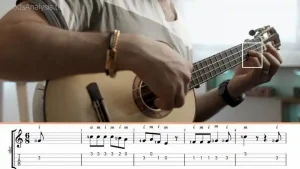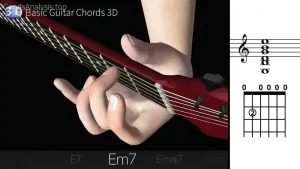Learning guitar can be a life-changing experience, whether you’re in your teens or in your 50s or beyond. It’s never too late to pick up an instrument, and the guitar, with its wide appeal and adaptability, is one of the best choices. But before you can start rocking out to your favorite tunes, you need to get comfortable with the basics – and that starts with learning some simple chords.
Let’s break this down, step-by-step, to help you start your guitar journey in a way that’s both practical and enjoyable. And yes, we’ll discuss the potential pitfalls too, so you’re well-prepared!
1. Understanding Guitar Chords
Guitar chords are essentially combinations of notes played simultaneously. In the simplest terms, they are the building blocks of music, allowing you to play melodies and harmonies. But before we dive into specific chords, let’s talk about how the guitar is structured.
A typical guitar has six strings, each tuned to a specific note:
- 6th string (thickest) – E
- 5th string – A
- 4th string – D
- 3rd string – G
- 2nd string – B
- 1st string (thinnest) – E
When you press down on certain frets along these strings and strum them, you form a chord. Different chord shapes will use different combinations of strings and frets.
2. The Basic Chords Every Beginner Should Know
There are hundreds of chords on the guitar, but as a beginner, you’ll want to focus on the basic open chords. These are chords that use open strings (strings that are not pressed down) and are simple to learn. The main ones are:
- C Major (C)
- G Major (G)
- D Major (D)
- A Minor (Am)
- E Minor (Em)
- E Major (E)
- A Major (A)
Why These Chords?
These chords are used in countless songs across genres, from pop to rock to folk. Learning them gives you a solid foundation and will allow you to play a huge variety of music.
3. How to Play Basic Chords
Let’s take a closer look at how to play each of these basic chords. We’ll go over the finger placement and the easiest way to start practicing them.
1. C Major (C)
- Place your ring finger on the 3rd fret of the 5th (A) string.
- Place your middle finger on the 2nd fret of the 4th (D) string.
- Place your index finger on the 1st fret of the 2nd (B) string.
- Let the 6th string (E) stay muted by not playing it.
- Let the 3rd string (G) ring open.

Tip: The key here is to avoid the low E string when strumming. This might take some practice to get it clean.
2. G Major (G)
- Place your middle finger on the 3rd fret of the 6th (E) string.
- Place your index finger on the 2nd fret of the 5th (A) string.
- Let the 4th (D), 3rd (G), and 2nd (B) strings ring open.
- Place your pinky finger on the 3rd fret of the 1st (E) string.
Tip: Make sure your fingers don’t mute other strings unintentionally. The G chord can feel awkward at first but practice will make it easier.
3. D Major (D)
- Place your index finger on the 2nd fret of the 3rd (G) string.
- Place your middle finger on the 2nd fret of the 1st (E) string.
- Place your ring finger on the 3rd fret of the 2nd (B) string.
- Let the 5th (A) and 6th (E) strings stay muted.
Tip: This chord is all about finger placement. You’ll want to make sure each finger is placed firmly on its fret.
4. A Minor (Am)
- Place your index finger on the 1st fret of the 2nd (B) string.
- Place your middle finger on the 2nd fret of the 4th (D) string.
- Place your ring finger on the 2nd fret of the 3rd (G) string.
- Let the 5th (A) string ring open.
Tip: This chord has a nice, melancholic sound, and is very common in many genres.
5. E Minor (Em)
- Place your index finger on the 2nd fret of the 5th (A) string.
- Place your middle finger on the 2nd fret of the 4th (D) string.
- Let all other strings ring open.
Tip: This is one of the easiest chords to learn because it requires only two fingers.
6. E Major (E)
- Place your index finger on the 1st fret of the 3rd (G) string.
- Place your middle finger on the 2nd fret of the 5th (A) string.
- Place your ring finger on the 2nd fret of the 4th (D) string.
- Let the 6th (E) and 2nd (B) strings ring open.

Tip: Practice transitioning between Em and E for a smooth progression between minor and major chords.
7. A Major (A)
- Place your index finger on the 2nd fret of the 4th (D) string.
- Place your middle finger on the 2nd fret of the 3rd (G) string.
- Place your ring finger on the 2nd fret of the 2nd (B) string.
- Let the 5th (A) string ring open.
Tip: This chord is often the hardest for beginners to get a clean sound from, but with practice, it’ll become second nature.
4. Common Problems and Solutions
Here are a few common issues beginners face when learning basic chords, and how to overcome them:
1. Buzzing Sounds
If your strings sound muffled or buzz when you strum, it’s usually because your fingers aren’t pressing down firmly enough, or you’re accidentally muting other strings. Solution: Try adjusting the pressure of your fingers and make sure each note rings clearly.
2. Hand Fatigue
Learning guitar can be hard on your hands, especially if you’re pressing down hard on the strings. Solution: Take regular breaks, stretch your fingers, and make sure you’re not holding the guitar too tightly.
3. Chords Not Transitioning Smoothly
Transitioning between chords is tough at first, but with consistent practice, it gets easier. Solution: Slow down and practice switching between two chords until you’re comfortable before speeding up.
5. How to Practice Effectively
- Start Slow: Don’t rush. It’s better to play slowly and accurately than to speed through and make mistakes.
- Use a Metronome: This helps with timing and rhythm, which are essential for smooth playing.
- Practice Regularly: Even just 10-15 minutes a day can lead to rapid improvement.
- Focus on Transitions: The hardest part of learning chords is transitioning smoothly. Spend extra time on this.
6. Real-Life Experiences
Let’s hear from a few people who’ve gone through this process themselves. Here’s what they had to say about learning basic guitar chords:
- Sarah, 32, USA: “I started learning guitar last year, and at first, I thought I’d never get it. But after sticking with it, those basic chords started coming naturally. It was so satisfying to finally play my first song!”
- James, 55, UK: “I always wanted to learn the guitar, but I thought it was too late for me. I was wrong! The key is not to rush and to focus on the fundamentals. Now I can play along to most of my favorite songs, and it’s a great way to relax.”
- Maria, 41, Brazil: “I struggled with finger pain at first, but I made sure to take breaks and stretch. The most important lesson I’ve learned is to be patient. Eventually, you build strength in your fingers, and the pain goes away.”
- Kei, 26, Japan: “As a left-handed player, I initially felt like I was at a disadvantage. But I quickly learned that with the right guidance and practice, the basic chords are accessible no matter which hand you use. It’s all about practice and persistence.”
Conclusion
Learning basic guitar chords is a rewarding journey that will open up the door to countless musical possibilities. Whether you’re playing for fun, relaxation, or performance, the skills you develop along the way will stay with you. Yes, there may be moments of frustration, but remember: every great guitarist started exactly where you are now.
So, grab your guitar, start with those basic chords, and enjoy









